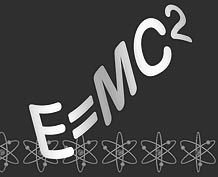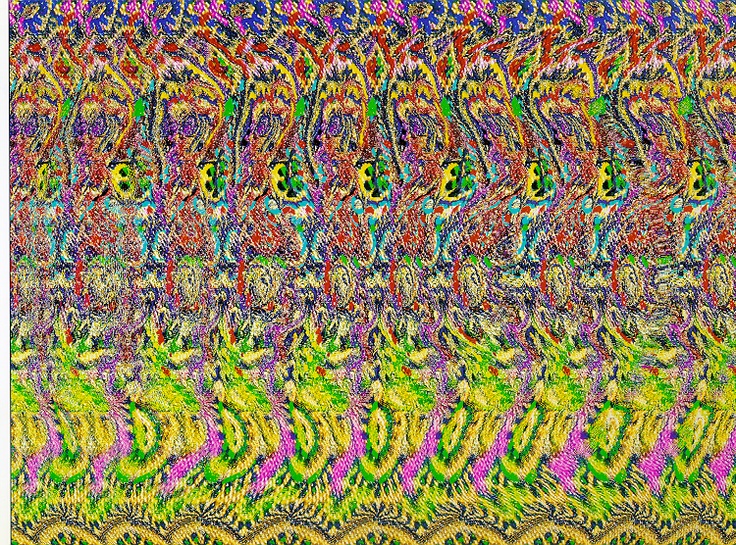


One is an elaboration of the Trent modular 3D concept, in which the depth structure repeats around the same repetition interval as the base pattern, with progressive variations to provide the requisite binocular disparities. There are two basic techniques used with these full-color image base patterns. The requirements of the shifting horizontal positions in adjacent repeats to support the depth image stretch and degrade the recognisable images, especially where there are abrupt changes in disparity within the depth image. In many cases, the designers of these autostereograms abandoned the idea of camouflaging the 2D information and instead organized the repeating patterns into multiple versions of recognisable images (Figure 5), often spatially related to the depth image. These usually required the eyes to overdiverge in order to get the 3D effect, which is rather harder for most people to achieve than overconvergence. The fourth phase of autostereogram development was the explicit, full-color images by Magic Eye and many other commercial companies. (After Hawlisch (2003) from Wikimedia Commons: )
Reveal stereogram movie#
In 1968, Julesz extended this concept to camouflaging the dynamic structure of moving objects by generating stereoscopic movie sequences in which the random-dot pattern was randomly regenerated for every frame to avoid the spatial correlations over time that are formed by physical moving objects (Julesz & Payne, 1968).įigure 5: Structured pattern autostereogram of a heart. These computer-generated 3D images used the computerized random-dot stereogram approach, developed by Bela Julesz in 1960, to camouflage the structure of the depth image being represented in the autostereogram when viewed directly. This technique, known as the single-image random-dot stereogram (SIRDS), was published by Tyler in a visual science textbook (Tyler, 1983), by David Stork in a computer science compendium (Stork, 1986), and by Dan Dyckman in a computer game magazine (Dyckman, 1990). The third phase was the development of the algorithm for mapping any arbitrary depth image into a random-dot autostereogram by Christopher Tyler in 1979 in conjunction with programmer Maureen Clarke. (Edward Trent, 1972, Bulletin of the Stereoscopic Society.) Alternatively, one can relax the eyes to diverge them farther from the wall, so that the wallpaper appears to float at a distant location farther than its actual distance.įigure 4: Geometric pattern autostereogram of a crystalline structure. One sees the wallpaper floating in space in front of its true position. Now the visual patterns viewed by the eyes are identical, except for the unpaired parts of the pattern in far peripheral vision, but the convergence angle is closer than the wall. At a certain point, one part of the repeating pattern is imaged in central vision of the left eye and that part's neighbour, immediately to the left, is imaged in central vision of the right eye. To see this illusion, view a flat wall covered with a wallpaper showing a regular, horizontally repeating pattern then converge the eyes on a point in space closer than the wall. He observed, and worked out the principles of, the wallpaper illusion. The first phase was the early conceptual development, which began with Sir David Brewster in 1844. The history of the autostereogram falls into five phases. In order to do so, however, the viewer must overcome the natural tendency of the eyes to focus at the convergence distance, and enable the eyes to refocus at the plane of the image. The disparity structure may be designed to correspond to the depth map of any desired three-dimensional scene, which is perceived when the eyes are held at the appropriate convergence angle. When the eyes either converge or diverge at the distance of the pattern repeat, small differences between adjacent pattern cycles provide binocular disparities that are interpreted by the viewer as differences in depth. When viewing with normal convergence of the eyes on the physical plane, the image appears only as a flat repeating pattern. The principle of the autostereogram is a horizontally repetitive image in which the repeated pattern is modulated in such a way that the image can be viewed with an abnormal convergence or divergence angle to generate the visual impression of a stereoscopic depth image within the space of the pattern.

Christopher Tyler, The Smith-Kettlewell Eye Research InstituteĪutostereogram refers to a single-image form of stereograms that can be free-viewed to achieve a stereoscopic, three-dimensional (3D), depth effect without a stereoscope or any other artificial aids to binocular fusion (see Figure 1).


 0 kommentar(er)
0 kommentar(er)
